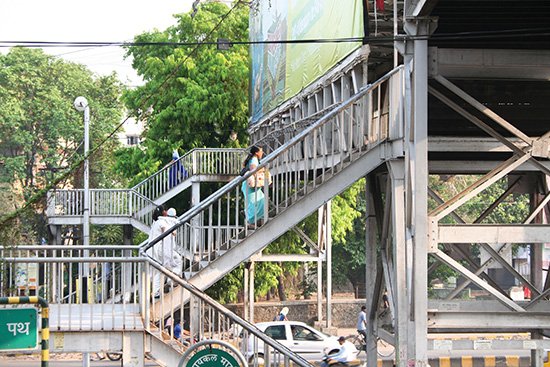This study has also raised the alarm bells for organisations like Parisar, working for sustainable transportation because of the fact that a mere 7% of respondents preferred a safe at grade crossing, indicating their inability to even visualise safety in at grade crossings.
 The observations from Parisar’s previous study – ‘Searching High and Low’ resonate with the findings in this study. It was realized during the course of the interviews that many people did not understand or relate to the concept of a ‘functional’ zebra crossing, as they had never experienced one! This goes a long way to show the plight of execution of traffic norms in the city. New concepts being introduced in the city, like pedestrian signals, must be introduced along with appropriate enforcement mechanisms and sufficient explanation and guidance to the citizens – both motorists and pedestrians – who are expected to benefit from it.
The observations from Parisar’s previous study – ‘Searching High and Low’ resonate with the findings in this study. It was realized during the course of the interviews that many people did not understand or relate to the concept of a ‘functional’ zebra crossing, as they had never experienced one! This goes a long way to show the plight of execution of traffic norms in the city. New concepts being introduced in the city, like pedestrian signals, must be introduced along with appropriate enforcement mechanisms and sufficient explanation and guidance to the citizens – both motorists and pedestrians – who are expected to benefit from it.
There is a general lack of awareness among citizens regarding their rights as pedestrians and the Municipal Corporation has also not been able to do something substantial on this front. Pedestrians must awaken to the fact that they are not the ones polluting the air and they are not the ones causing huge traffic jams. They must be actively involved in the form of pressure groups, and must respond via newspapers, letters etc. to demand what they want from the authorities. They deserve more than being honked at.
The authorities must consult the people before they decide to introduce anything new in the city. This could be done by coordinating with NGOs and civil society organizations. This increases accountability and active participation of citizens in the planning of their own city. It was suggested that the municipal corporation take up the drafting of a Pedestrian Policy and Street Design Guidelines for the city, wherein it can be ensured that solutions for pedestrian safety meet the following criteria;
Direct pedestrian routes – the shorter the way, the more people are likely to stay pedestrian
Good connectivity – e.g. bus stations close to the residential homes, so that walking becomes the main public transport feeder
Convenience – people tend to choose the easy way, so make walking easy. That includes walkable footpaths, shaded walkways, enough space to pass other pedestrians, curved pavement edges, benches to rest and most important of all the avoidance of steps
Safety – as the most vulnerable traffic participants, pedestrians need best protection. Continuous and unobstructed footpaths on every street are a necessity, as also well designed and implemented pedestrian crossings.
While safe at grade crossing is undoubtedly the most user-friendly, cost effective way of managing the situation, it requires a change in the mindset of the authorities as also that of the people themselves. Whether we want our pedestrians to be lifted off the roads to make way for vehicles or whether we want equitable, people-friendly roads and cities is a question that looms large in front of us in the wake of incessant, thoughtless infrastructure development.
Shweta Vernekar Navlakha Project Co-ordinator, Parisar (The study was conducted by Enrico Erler and Nandita Bijur for Parisar)
 TrafficInfraTech Magazine Linking People Places & Progress
TrafficInfraTech Magazine Linking People Places & Progress
